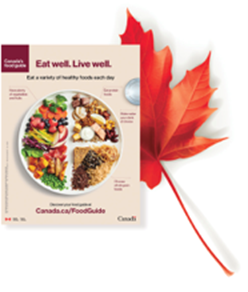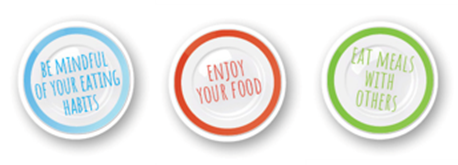Managing Diabetes Highlights:
- Think of vegetables as the stars of your plate, and choose them most often.
- Divide your plate into quarters. Fill half with vegetables and fruit, a quarter with whole grains, and a quarter with protein.
- Aim for a healthy proportion of food types, rather than focusing on certain amounts.
- Meat, milk products, beans and lentils all count as proteins.
Including a variety of healthy foods in each meal helps us to eat and live well. These healthy eating tips are based on the most recent version of Canada’s Food Guide, a practical tool that promotes balance at every meal. It describes not only what to eat, but how we should eat. Eating a diet with more plants can lower the risk of chronic health conditions like heart disease, diabetes and certain types of cancer.
LINK Canada’s Food Guide: food-guide.canada.ca/en
What’s new in Canada’s Food Guide?
If you grew up with older versions of Canada’s Food Guide, you’ll find a few changes. The most recent guide takes a broader approach, focusing on the proportion of foods rather than portion sizes. Divide your plate into quarters, and fill half your plate with vegetables and fruit, one quarter with whole grains, and one quarter with protein foods.
Another big change is that the familiar four food groups are a thing of the past. As well, you will no longer find recommended serving sizes or numbers of servings.
The guide also considers cultural preferences, food traditions and environmental impacts. It encourages families to enjoy food, eat together, cook more often, and be mindful of eating habits.
Boost your vegetables and fruit
Make vegetables and fruit the star of your plate. They should fill half of your plate at every meal. Vegetables and fruit are full of fibre, antioxidants, vitamins and minerals. Fresh, frozen and canned vegetables and fruits are all good choices.
- Make it easy. Buy ready-to-eat vegetables like cherry tomatoes, pre-washed salad greens and baby carrots. Look for pre-cut fruit and vegetables.
- Use frozen vegetable mixes in spaghetti, stew or slow-cooker recipes.
- Keep canned or frozen fruit on hand for fruit salad or smoothies.
- Add extra vegetables to casseroles and soup.
- Add dried fruit to cereal or oatmeal.
- Roast or grill vegetables and fruit for a new flavour. Try peppers, cauliflower, squash, peaches or pineapple.
Get the Guide: food-guide.canada.ca/en

Protein power
Two food groups – the former Milk & Alternatives and Meat & Alternatives – are now replaced by a quarter plate of protein foods.
The new guide suggests eating plant-based protein more often, but still includes fish, seafood, meat, poultry and eggs. Plant-based proteins include beans, lentils, nuts, seeds and soy products. They have less saturated fat and more fibre, and are easy on the wallet.
You can include more plant-based protein foods in your meals in several easy ways.
- Start small. Gradually increase plant-based protein sources at meals. Try swapping half the meat for plant-based protein like lentils or TVP (textured vegetable protein) in recipes.
- Plan one meatless meal during the week.
- Stock your kitchen with a variety of canned beans and lentils. Simply drain and rinse before adding to your recipes.
- Top salad and stir-fry with chickpeas, almonds or cashews.
- Stir black beans into your favourite rice dish or add to salsa for a more filling dip.
- Add dried lentils to homemade soup. They cook quickly without the need to presoak.
- Choose a flavored hummus as a dip for veggies.
- Snack on roasted chickpeas or soy nuts.
To make your heart happy and healthy, have a meal with fish or seafood at least twice a week, and choose lean cuts of meat or skinless poultry.
Although dairy products no longer have their own food group, they still have a place in Canadian diets as part of the quarter plate of protein foods. Dairy products, such as lower fat milk, yogurt, kefir and cheese, provide protein and important nutrients like calcium and vitamin D.
Go whole grain
- Fill a quarter of your plate with whole grains at meals.
- Choose breads made with 100 per cent whole grain.
- Try whole grain pasta instead of white.
- Use quinoa in place of white rice or noodles in cold salads.
- Enjoy popcorn as a snack – but watch the toppings and salt.
- Add barley, brown rice or corn to soups or salad bowls.
- Swap quinoa, barley, or oat groats for white rice in pilaf or risotto recipes.

Personalize it!
Canada’s Food Guide provides general nutrition guidance for healthy Canadians. If you have dietary concerns or a health condition, a registered dietitian can provide advice on how to personalize the guide to meet your needs. Registered dietitians are the only regulated nutrition professionals in Canada, with the unique education, training and experience to find food solutions that work for you and your family.
WRITTEN BY: Laurie Barker Jackman, RD, a registered dietitian in Halifax, Nova Scotia.
